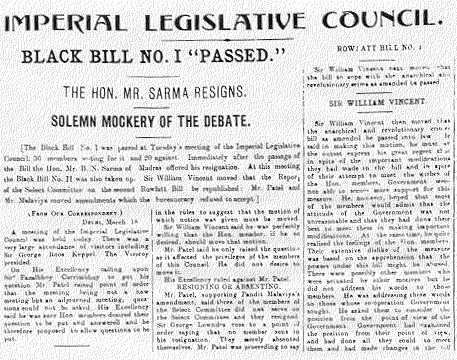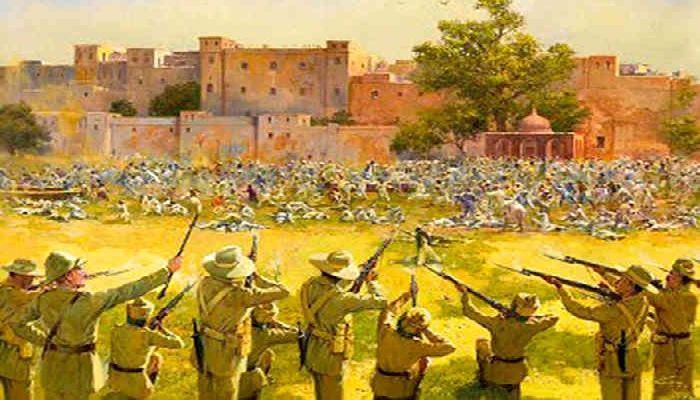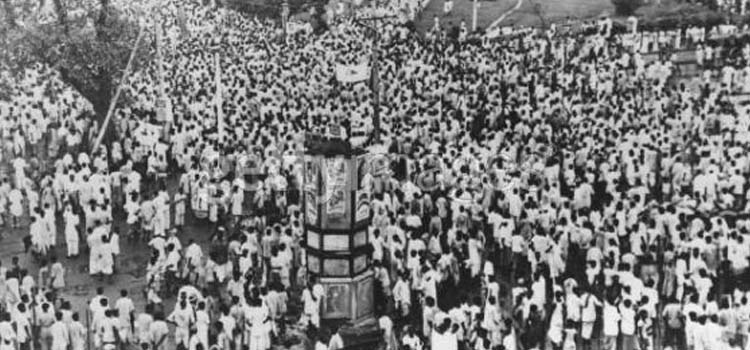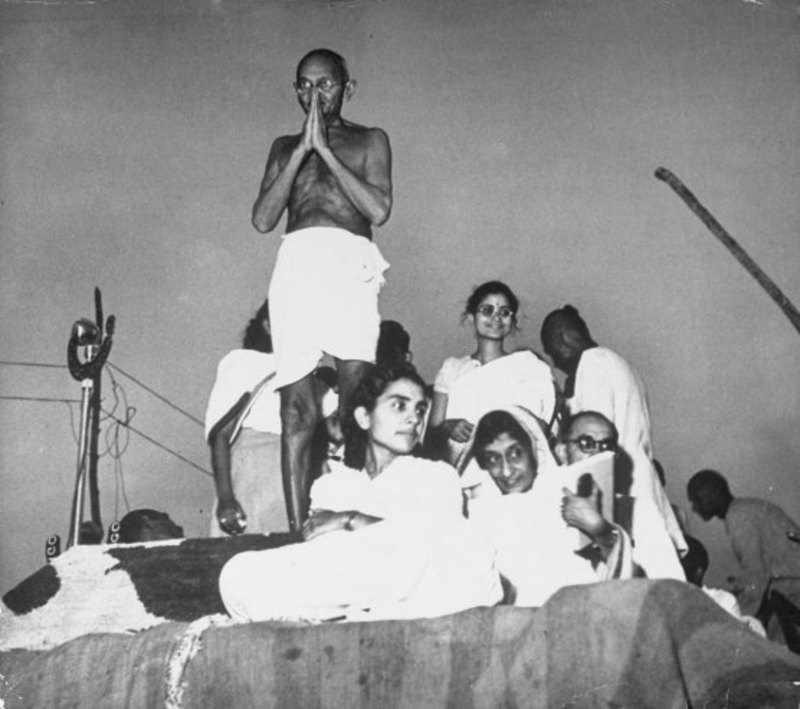With Montague’s declaration in August 1917 the Home Rule Movement gradually came to an end Mrs. Annie Besant declared whatever they were demanding they achieved. Tilak went to London to fight a case against Chirol because she had termed Tilak as the father of Indian arrest.
The issue of the Rowlatt act & Khilafat issue provided a new direction to India’s struggle against British Rule leading to the launching of the Non-Cooperation Movement on 1 August 1920.
Rowlatt Act & Non-Cooperation Movements

At the instruction of Governor-General Lord Chelmsford (1916-21), a committee was appointed under Justice Sydney Rowlatt to prepare a draft for a bill to check revolutionary crimes. This will provided for the continuation of wartime restriction as anybody’s house could be searched without warrants anybody could arrest on suspicious.
Despite the strong opposition of Indian nationalists such as Gandhiji, the Rowlatt was enacted in March 1919. Jalianwalan Bagh massacre of 13 April 1919 revealed the true face of British colonial rule hundreds of innocent civilians were murdered mercilessly by General Dyer. Hunter committee appointed to looking to Jalianwalan Bagh massacre carried out just whitewash. Not a single officer was held guilty.

The Rowlatt act & Jalianwalan Bagh massacre intensified anti-British discontent prevailing among the masses. When Gandhiji returned from Africa, he had a strong faith in the British sense of justice & fairness. But this faith was shattered by these two incidents
Khilafat Issue

Peacemakers of Paris imposed the “Treaty of Sèvres” on the ottoman empire/Turkey provisions of this treaty provided for fragmentation of the ottoman empire. Treaty of Sèvres was a serious attack on the prestige of khalifa because as result khalifa no longer enjoyed control over holy Islamic places.
The Treaty of Sèvres triggered a sharp reaction from Muslims all over the world. In September 1919, several Muslim leaders such as Maulana Abul Kalam Azad, Hakim Ajmal Khan, Hashrat Mohani, Mohammad Ali & Shaukat Ali formed the “All India Khilafat” committee to oppose the treaty of serve.
Gandhiji joined the khilafat committee as he was convinced that the khilafat issue was the best opportunity to forge the bond of permanent unity between Hindu & Muslim. He was opinioned that unity forged on the emotional issue would be lasting.
Gandhiji’s opinion was that if Hindus supported Muslims at times their sentiment deeply hurt, Muslims would also support Hindu. Gandhiji believed that Lucknow unity 1916 failed because that involved elite class of Hindu & Muslim participation of common masses was absent in unity established through Lucknow pact in 1916.

In November 1919, Gandhiji was elected as chairman of the khilafat committee. When they talked if the British failed he advised members of the committee to launch a non-cooperation movement. On 9th June 1920, the khilafat committee decided to launch the Non-Cooperation Movement & Gandhiji. On 1 August 1920, Non-Cooperation Movement was launched by the Khilafat committee under Gandhiji.
Participation of Congress in Non–Cooperation Movement
Gandhiji was aware of the fact without the support of congress, no Mass Movement would succeed so he advised Congress to launch Mass Movement against British Rule. In September 1920, congress held its special session at Calcutta under the leadership of Lala Lajpat Rai & it decided to launch Mass Movement on three issues or with three demands grant of Swaraj, restoration of the prestige of caliphate (Khilafat issue), and Rectification of Punjab wrongdoings (officers responsible for Jalianwalan Bagh must be punished).
On 4 September the movement of the congress was launched it’s also known as the non-cooperation movement hereafter the movement of the congress was known as the “Khilafat movement”. After 4 September 1920, khilafat Movement & Non-Cooperation Movement continued as parallel-twin movements (“twin movement”).
Was Khilafat unity a mistake on part of Congress?
Khilafat Unity or support of congress to Khilafat Unity is strongly criticized by a section of scholars who believed that it was a big mistake on part of congress. The critics of Khilafat Unity emphasized that it justified the use of religion in the National Movement. It seriously affected the secular character of the anti-British struggle.
It subordinated common national cause to a narrow religious issue concerning a small section of the Indian population. Khilafat Unity called to be anti-nationalism because it was based on the idea of Pan Islamism. Unity failed almost completely because when Mustafa Kamal Pasha’s leader of the Turkish revolution of 1921 abolished the caliphate. Khilafat Movement area out suddenly most of Muslim moved out anti-British struggle.
Though Khilafat Unity was a failure as it did not succeeds in keeping Hindu & Muslims together but it was not correct to see that it was a mistake of congress. Khilafat Unity was based on noble, secular, nationalist objectives its only objective to strengthen the Anti-British Struggle by pulling Muslims into it & by raising the level of national awakening between them.
Congress supported Khilafat Unity so that anti-British discontent prevailing among the masses could be transformed into a strong nationalist awakening. Just because the unit failed the intention behind it should not be questioned therefore it was not a mistake as part of congress.
Significance of Non-Cooperation Movement
It transformed the anti-British struggle into a true mass movement. The social base of the National Movement was widening significantly because the women, students, peasants & working-class participated in it in large numbers. The fear of the British Rule got erased from the heart & mind of the masses.
The efficacy of Gandhian methods of struggle was proved because Gandhiji could mobilize lacs of Indian quite successfully. Non-Cooperation Movement played an important role in the empowerment of women because the role of women was very important, the social attitude towards women changed significantly as a result of their contribution to the anti-British struggle.
The level of nationalist awakening was carried to a new height by Non-Cooperation Movement because at the time of launching Gandhiji had promised Swaraj within the first year. When Non-Cooperation Movement suspended & withdrawn suddenly as a result of the Chauri Chaura incident, a sense of disillusionment gripped a large section of Indian National. Their hopes of winning swaraj got shattered. Leaders like SC Bose commented that the sudden withdrawal of the Non-Cooperation Movement was catastrophic.
Why did Gandhiji withdraw Non-Cooperation Movement?

The sudden withdrawal of the Non-Cooperation Movement by Gandhiji in February 1922 was opposed by many leaders. It was termed as catastrophic but closer examination of the nature & character of the Gandhian movement revealed that the decision was neither sudden nor unexpected.
Gandhian Movement was a non-violent movement; Gandhiji knew that only non-violent methods could succeed against British Rule. He was aware of fact that violent incidents like one that took place at Chauri Chaura place provide an excuse for to British to suppress mass agitation by force.
Gandhiji was aware of fact that the struggle against British Rule was bound to be long run out because British colonial rule was well entrenched in India. He didn’t want to invest his energy in one movement itself because he knew that in the future much such movement required pushing the British out of India.
So when no trace of Swaraj was visible even after fighting for more than a year, Gandhiji withdrew Non-Cooperation Movement on the pretext of the Chauri Chaura incident. Gandhiji was a great leader of masses; he felt the pulse of masses perfectly. He knew that due to the continuous fight of the first and half years against British Rule, the people were losing their energy.
Being a man of wisdom Gandhiji could understand that the Chauri chaura incident was reflecting the frustration of people rather than the strength of people. Therefore he decided to suspend mass agitation & movement was called off. Gandhian Movement was based on strategy Struggle Truce Struggle & Pressure Compromise Pressure theory. Gandhi always used to keep the window of compromise open because he knew that the partial success or voluntary withdrawal of movement was a better option than the death of mass agitation naturally.
Therefore Gandhiji withdraws Non-Cooperation Movement because people could lose their energy completely & the movement could die out. Gandhiji was aware of fact that common masses can’t be expected to behave like revolutionary. They had their limit of sacrifice. He was aware of the fact that Mass Movement can’t continue forever so no gain was coming from the British side even after fighting for 18 months. He decided to withdraw Mass Movement in February 1922 Chauri Chaura’s incident provided a high moral ground from where the movement can be withdrawn effectively without affecting the morale of the masses.

